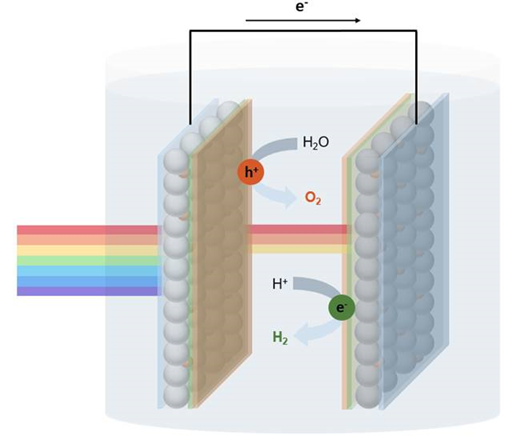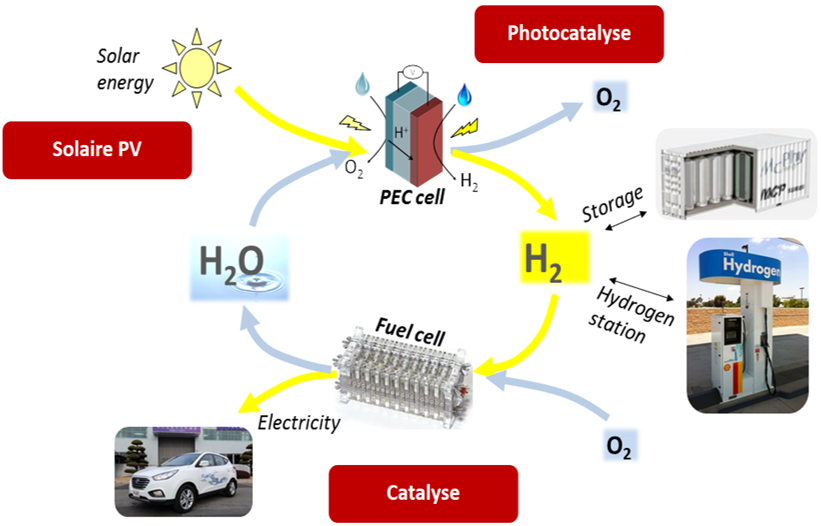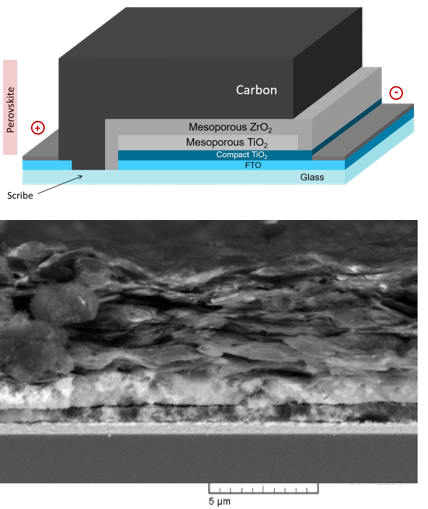


|
|
In the very active field of chemistry and material-science for renewable energy prodcution, conversion and storage, the Licsen mostly studies : (1) H2 to electricity conversion in platinum-free fuel-cells (of PEMFC type), with a focus on the cathode side (ORR being the most limiting factor); (2) Green H2 production by photo-electro-catalysis; (3) Perovskite-based tandem photovoltaic cells and in particular, their stability. Find more details below. |
|
|
Chemistry and material science for platinum-free hydrogen fuel-cells : In the actual global plan towards a sustainable energy future, fuel cells are promising candidates for a clean and efficient energy conversion, with a wide range of applications. The power loss at fuel-cell cathodes during Oxygen Reduction Reaction (ORR) is among the most limiting factors of the chemical-energy-based conversion. The slow ORR kinetics on Pt-catalysts, their low availability and high cost make alternative Pt-free catalytic materials highly desirable for improved performances of fuel cells. The activities of the LICSEN group lie at the interface between the development of new materials and the operation of elementary PEM cells. We develop platinum-free catalysts on highly electroactive carbon support, as well as robust and cost-efficient shaping methods to produce medium- to large-scale PEMFCs. Beyond the catalytic material itself, the fuel cell (bipolar plates, membrane-electrode assembly, catalyst support layers) is studied and optimized. Research efforts focus on improving ORR efficiency, studying the impact of catalyst layer microstructure on performance and understanding the limiting factors using electrochemical techniques (rotating disk electrode, cyclic voltammetry and impedance spectroscopy).
Main contacts: Bruno Jousselme, Renaud Cornut, Frédéric Oswald and Mélanie François Further reading: PEGASUS EU-project / Electrochem. Commun. (2023) / Vers une pile à combustible sans métaux nobles (in French) / ChemElectroChem (2023) / Analytical Chemistry (2022) / Chemical Science (2021) |

|
Photocatalytic hydrogen production: The future of energy supply depends on innovative breakthroughs regarding the design of efficient systems for the conversion and storage of the most available source of renewable energy: solar energy. The production of hydrogen through direct sunlight-driven water splitting in a Photo-Electro-Chemical (PEC) cell appears as a promising and appealing solution. Such cells need to respond to 3 main characteristics: sustainability, cost-effectiveness and stability. Fulfilling these requirements raises important scientific questions regarding mainly the elaboration and the combination of the best possible materials able to harvest light and catalyze H2 and O2 evolution. Efficient PECs have been made using expensive materials and complex methods. In line with the trend, the LICSEN laboratory has focused its activities on the development of efficient and large-area photoelectrodes based on non-precious materials and fabricated using common low-cost techniques (doctor blade coating, screen printing, inkjet printing, spray coating, etc.). The main research is devoted to reducing electron-hole recombination to improve the efficiency of semiconductor-based devices. Various research efforts are focused on minimising recombination losses in the bulk and at the surface of semiconductors by interface engineering with the creation of interfacial layers between different materials in a device, passivation layers that create a protective barrier against defects and dangling bonds, doping control to improve carrier collection efficiency, and structuring to increase the absorption of photoelectrodes. Main contacts: Bruno Jousselme, Frédéric Oswald and Mélanie François. Further reading: PROSPER-H2 ANR-project / All solution-processed organic photocathodes / A H2-evolving photocathode based on direct sensitization of MoS3 / De l'hydrogène par électrolyse de l’'eau sans platine (in French) /ChemElectroChem (2023) / J. Am. Chem. Soc. (2019) |
|
Triple mesoscopic architecture and SEM image of a carbon-based perovskite solar cell (PSC)
|
Perovskite photovoltaic : In the very challenging race for sustainable energy sources, metal halide perovskite solar cells (PSCs) have undergone unprecedented progress with efficiencies of 26.1% and even 33.7% in tandem configuration. But their limited stability prevents their mass production. Encapsulation methods have been developed to prevent moisture and oxygen from permeating into the perovskite layer but could not sufficently improve photo and thermal stability. A one-year stable (under constant illumination) perovskite module has been recently published. This device uses a carbon counter electrode that significantly enhances lifetime and has become one of the most prevailing scaffolds for constructing stable PSCs. Since then, carbon electrode-based perovskite solar cells have established as highly promising architectures for the next generation of stable and high efficiency PV-cells. The fully printable design of the carbon based triple mesoscopic architecture enables rapid upscaling while materials and processes allow for sustainable manufacturing. Single-junction perovskite photovoltaic devices enable greater than 1.0 V open-circuit voltage generated by a perovskite with a bandgap of 1.5 eV. PSCs can be combined in series with another perovskite or silicon to produce an operating voltage exceeding 1.7 V, which can surmount the potential required for unassisted water splitting at high current densities. While these performance and characteristics of perovskite devices are very well suited for water splitting, its extreme sensitivity to water makes it difficult to use such devices directly as photoelectrodes. LICSEN is developing fully printable PSCs based on triple mesoscopic carbon architectures. Through judicious choice of materials, the chemical composition of perovskite is tuned according to the needs of the various projects (bandgap modification, current matching to photoanode for water splitting,etc…). This architecture is also tested in real outdoor operating conditions at SIRTA on a photovoltaic testing platform currently under development. This activity is developped in very tight collaboration with the LPICM (Ecole Polytechnique). Main contacts: Frédéric Oswald and Bernard Geffroy (now retired) Further reading: X-ETL ANR-project / TRAPPER ANR-project / Scientific Reports (2022) / J. Photon. Energy (2020) / J. Phys. Chem. C (2019) |
•  Institut Rayonnement Matière de Saclay
Institut Rayonnement Matière de Saclay
• Laboratoire d'Innovation en Chimie des Surfaces et Nanosciences (LICSEN)







